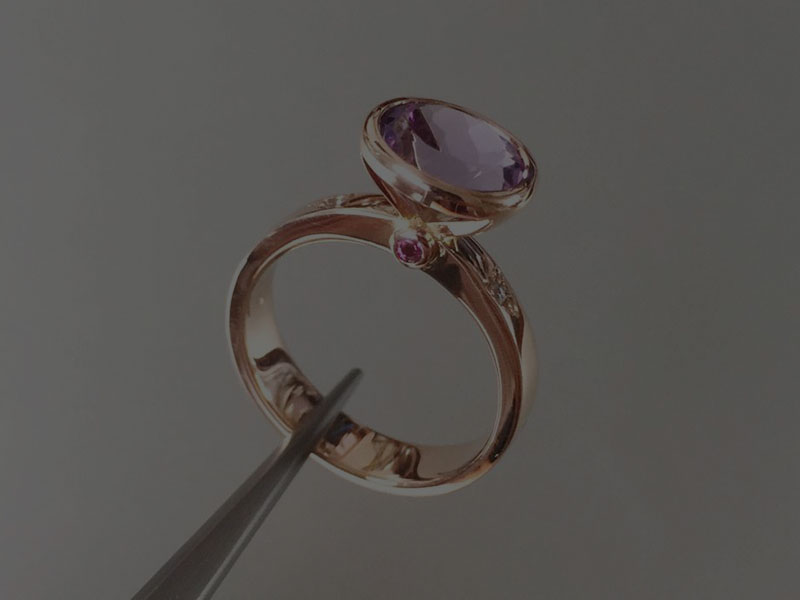In Australia, gold generally comes in two purities – 9ct and 18ct (or 9k and 18k if you’re outside of Australia). But what is the real difference between the two? It’s one of the most common questions I’m asked as a custom jewellery designer (and when you’re spending thousands of dollars on a piece of bespoke jewellery, it’s important to know the difference). That’s why I’ve created this resource: The non-judgmental guide to choosing the best gold for you.
Slick marketing will tell you that the more expensive the piece, the more luxurious it is. Many assume that 18ct gold is automatically “better” due to its higher price and perceived exclusivity. It can be, but this is not always the case.
Want quick answers? Here are my responses to the 4 most frequently asked questions. If you’d like to learn more, scroll down for a more detailed comparison.

What is the difference between 9ct and 18ct gold?
The primary difference is the precious metal content. 9ct gold contains 37.5% pure gold. 18ct gold contains 75% pure gold.
The remainder is an alloy of various metals, which may include copper, zinc, silver, palladium or platinum, depending on whether it’s a yellow, rose or white gold piece.
An 18ct gold piece will generally be more expensive than an equivalent 9ct gold piece, as it contains twice as much pure gold.
9ct vs 18ct gold - which one is better?
This totally depends on your situation. In general, and all factors equal, 18ct gold is the longer lasting, more durable choice. However 9ct gold can still be a great option for some. This is what I tend to recommend.
Choose 18ct gold if:
- You are looking for a piece that is worn frequently and needs to last as long as possible, like an engagement ring, wedding band or heirloom piece, and
- It fits into your budget
Choose 9ct gold if:
- You are looking for something in a lower price bracket, and
- You are after a piece that isn’t worn as regularly, like a dress ring or fashion jewellery
There are other factors that can influence the durability of a piece of gold jewellery, and it’s not quite as simple as looking at just the purity of the metal. Metal that has been hardened by being compressed and shaped during the handmaking process is likely to last longer than metal that has been cast into its final shape, whether it’s made in 9ct or 18ct gold.
Does 9ct gold tarnish?
Yes, 9ct gold can tarnish. However it doesn’t tarnish as obviously as sterling silver can. You may not notice it until you compare your 9ct gold jewellery to a brand new, freshly polished piece, and see that the surface looks slightly duller. Wiping with a jewellery polishing cloth will help remove the tarnish and bring back the original colour.
You will likely notice tarnish more on 9ct rose gold (due to the higher copper content) and less on white gold. White gold is usually plated with a fine layer of rhodium (a platinum group metal) which doesn’t tarnish.
The higher the gold content, the less likely it is that the metal will tarnish.
Is it ok to wear 9ct gold?
Yes! If it makes you happy, if you have considered the differences and if it means you can have the piece of jewellery you want within your budget, wear 9ct gold. Make your decision based on what’s best for you, not what other people think.
I happily make custom jewellery and engagement rings for clients in both 9ct and 18ct gold, depending on their budget and personal preferences. I also have a range of 9ct rose gold and 9ct yellow gold jewellery in the shop to provide more affordable options than I could in 18ct gold.

A more detailed comparison between 9ct gold and 18ct gold
Now that you’ve got the cliff notes, let’s get technical. Here is a more in depth rundown on the characteristics of 9ct gold and 18ct gold.
There are 3 factors to consider:
Durability: How much wear does your jewellery get and how long does it need to last?
Cost: What is your budget?
Appearance: What do you want your metal to look like?
As you already know, the most common types of gold you’ll find in Australia are 18ct and 9ct gold. Other countries may use different purities such as 10ct, 14ct and 22ct.
Carat (ct), also referred to as karat (k) in other countries, indicates the purity of the metal. Pure gold (24ct) is generally too soft to use in jewellery and is alloyed with other metals to increase its hardness.
- 9ct gold is 37.5% pure gold
- 10ct gold is 41.6% pure gold
- 14ct gold is 58.3% pure gold
- 18ct gold is 75% pure gold
- 22ct gold is 91.6% pure gold
Durability
A common question when comparing 9ct and 18ct gold is, “which one is most durable?”.
While 9ct gold is technically “harder” than 18ct gold, it can be more brittle and less resistant to knocks and scratches on a microscopic scale. All factors equal, an 18ct gold ring will hold up to everyday wear better than a 9ct gold ring when compared over a long period of time.
Resistance to tarnishing and corrosion is another factor to consider. Remember high school chemistry class? You may have heard of pure gold referred to as a “noble” metal, which is resistant to attack from chemicals, acids and the elements. Pure gold does not corrode or tarnish, but the other metals used to make gold alloys can. 18ct gold contains 75% pure gold and 25% other metals, while 9ct gold contains 37.5% pure gold and 62.5% other metals. Because 18ct gold contains less other metals, it’s more resistant to tarnishing and corrosion than 9ct gold.
Cost
18ct gold jewellery is generally higher in price than 9ct gold jewellery as it has double the pure gold content. If cost is a determining factor, 9ct gold can be a good option (after weighing up the other factors listed in this resource). Made well, a 9ct gold ring can also be built to last.
If you choose white gold, remember that a fine layer of rhodium (a platinum group metal) is often applied to both 9ct and 18ct white gold to give it a bright white finish. This rhodium layer wears off over time and can be reapplied to maintain its original finish. This is of course optional, but if you choose to replate your white gold jewellery, you may want to factor this into the cost of your ring over its lifetime.
Platinum is another option to consider if you’re looking for a durable white metal. Find out the difference between platinum and white gold.
Appearance
In general, the more pure gold there is in a ring, the warmer the yellow hue. 18ct gold rings have a richer, yellower tone than 9ct gold rings in both yellow and rose gold. White golds often contain silver, palladium and/or platinum (depending on the alloy) to offset the natural yellow colour. White gold alloys without palladium or platinum are generally warmer in colour than those with palladium or platinum.
While this is a general rule, different alloys from different manufacturers may show slight colour differences depending on how they are made.

The verdict – 9ct gold or 18ct gold?
If your budget allows, and if you’re looking for a long-lasting piece with heirloom potential, go for 18ct gold. If you are after a lower price point, 9ct gold may be an appropriate choice.
Remember that how your jewellery is made can have more of an impact on its durability than what metal it’s made in.
What about platinum vs white gold?
Another great question! Both are great options for fine jewellery and engagement rings. Here’s how to decide whether platinum or white gold is the right choice for you.
Have questions?
If you need help deciding which metal to go with, I’d be happy to answer your questions. Email fairina@fairinachengjewellery.com or book a free custom jewellery consult and we can chat about which option may be most suitable.
Want more advice about choosing an awesome piece of jewellery?
I specialise in unconventional jewellery for rule breakers and story makers. Get in touch and let’s chat about creating a piece of jewellery that’s beautiful, personal and intensely meaningful.
Alternatively, check out the helpful guides below.


